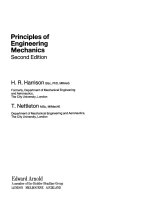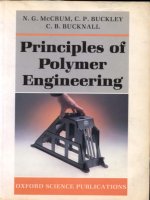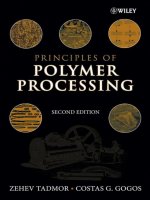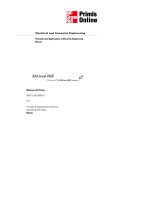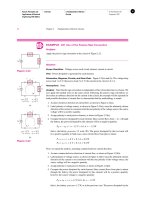principles of polymer engineering
Bạn đang xem bản rút gọn của tài liệu. Xem và tải ngay bản đầy đủ của tài liệu tại đây (46.46 MB, 403 trang )
Contents
0.
Introduction
0.1.
The past
0.2.
Engineering plastics
1.
Structure
of
the
molecule
1.1.
Introduction
1.2.
Addition polymers
1.3.
Condensation polymers
1.4.
Copolymers
1.5.
Cross-linked polymers
1.6.
Molecular symmetry and the tendency to form crystals
1.7.
Distribution of relative molecular mass
Problems
Notes
Structure
of
polymeric
solids
2.1.
Introduction
2.2.
Structure of the crystal
2.3.
Crystal shape
2.4.
Crystallinity
2.5.
Crystallization and melting
2.6.
The glass transition temperature
2.7.
Molecular conformation in the amorphous polymer
2.8.
The freely jointed chain
2.9.
The Gaussian chain
2.10.
Molecular orientation
Problems
Notes
3.
The
elastic
properties
of
rubber
3.1.
Introduction
3.2.
Structure of an ideal rubber
3.3.
Entropy elasticity
3.4.
Elasticity of a network
3.5.
Stress-strain relationship
3.6.
~n~ineerin~ rubbers
x
Contents
Problems
Notes
4.
Viscoelasticity
4.1. Introduction
4.2. The nature of viscoelasticity
4.2.1. Creep
4.2.2. Stress relaxation
4.2.3. Dynamic properties
4.3. Theory of linear viscoelasticity
4.3.1. The Zener model
4.3.2. Distribution of relaxation times
4.3.3. Origin of temperature dependence
4.4. Polymer selection: stiffness
4.4.1. Temperature dependence
4.4.2. Stress analysis
Problems
Notes
5.
Yield and fracture
5.1. Introduction
5.2. Yielding
5.2.1. Considhe's construction
5.2.2. Eyring's model of the
flow of solids
5.2.3. Yielding under multiaxial stresses
5.3. Crazing
5.4. Fracture mechanics
5.4.1. Measurement and application of
KIc
5.5. Fracture properties of polymers
Problems
Notes
6.
Reinforced polymers
6.1. Introduction
6.2. Reinforced plastics
6.2.1. Polymer matrices
6.2.2. Fibrous reinforcement
6.2.3. Platelet reinforcement
6.3. Forming of reinforced plastics
6.3.1. Pultrusion
6.3.2. Filament winding
6.3.3. Hand lay-up
6.3.4. Hand spray-up
Contents
xi
6.3.5. Compression moulding
6.3.6. Reinforced reaction injection moulding (RRIM)
6.3.7. Reinforced thermoplastics
6.4.
The mechanics of fibre reinforcement
6.4.1. Continuous fibres
6.4.2. Discontinuous fibres
6.5. Reinforced rubbers
Problems
Notes
7.
Forming
7.1. Introduction
7.2.
The flow properties of polymer melts
7.2.1. Bulk deformation
7.2.2.
Elongational~ow
7.2.3. Shear flow
7.3. Extrusion
7.3.1. Extruder barrel
7.3.2. Extruder screw
7.3.3. Die and calibration
equipment
7.4. Injection moulding
7.4.1. Hot runner moulds
7.4.2. The gate
7.4.3. Control of pressure, temperature, and time
7.4.4. Thermosets
7.4.5. Reaction injection moulding
(RIM)
7.5. Thermoforming
7.6.
Blow moulding
7.7. Compression and transfer moulding
7.7.1. Compression moulding
7.7.2. Transfer moulding
Problems
Notes
8.
Design
8.1. Introduction
8.2. Materials selection
8.2.1. The selection procedure
8.2.2. The 'big four' commodity thermoplastics
8.2.3. The engineering thermoplastics
8.2.4. Thermosets and composites
8.2.5. Rubbers
xii
Contents
8.3. Designing for manufacture
8.3.1. Injection moulding
8.3.2. Joining and fbstening
8.3.3. Thermosetting polymers
8.4. Designing for stiffness
8.4.1. PIastics
8.4.2. Fibre composites
8.4.3. Rubbers
8.5. Designing for strength
8.6. Case histories
8.6.1. Optical memory devices (compact discs)
8.6.2. Motorcycle drive sprocket
8.6.3. Cross-country ski bindings
8.6.4. Glass fibre -epoxy composite leaf spring
8.6.5. Helicopter blade
8.6.6. Cautionary tale no.
I
8.6.7. Cautionary tale no. 2
Problems
Notes
Further reading
Answers to problems
Index




